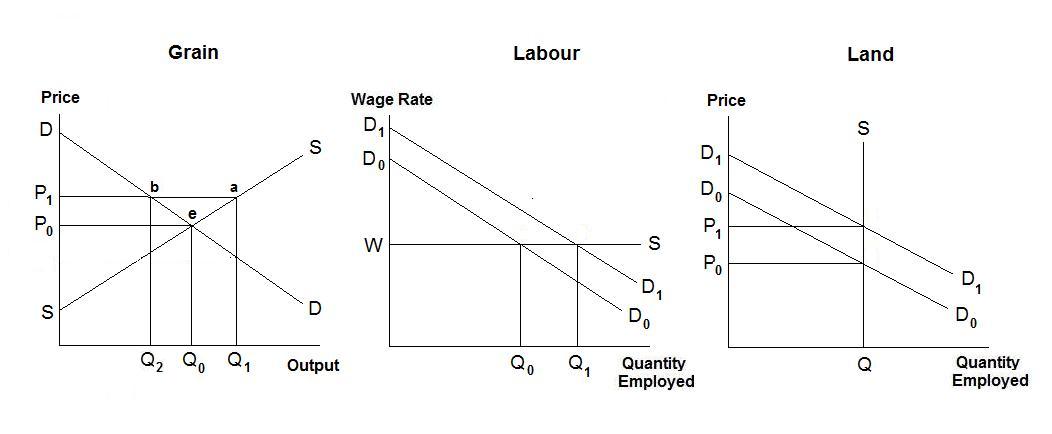
True or False?
Despite the fact that the poor abroad will be helped, the above argument is nonsense. This can be seen with reference to the Figure below. The left-most diagram gives the supply and demand for grain, the middle diagram gives the supply and demand for labour and the right-most diagram gives the supply and demand for land. Given that labour is continually moving out of grain production, it is reasonable to begin the analysis with the assumption that the supply of labour to grain production, given by the line WS in the middle diagram, is perfectly elastic at the wage rate W. In contrast, the supply of land is fixed, as indicated by the vertical line SQ in the diagram on the right. The supply curve of grain is upward sloping in the diagram on the left because the application of labour on the fixed stock of land yields diminishing returns, causing the average cost of grain to rise as the quantity produced increases.

Suppose now that the government supports the price of grain at P1 by purchasing the surplus of production over domestic demand that arises at that price, Q1 − Q2 , and shipping it abroad to feed the poor. The total cost of the program in terms of taxpayers money is b a Q1 Q2. As production expands, the demand curves for labour and land shift to the right to D1D1 in the two factor markets. For convenience, we ignore capital by essentially assuming that it behaves in the same way as labour. The quantity of labour employed increases from Q0 to Q1 in the middle diagram and the wage received, or implicit wage received on farms that are owner-operated, remains at W. The quantity of land employed does not increase and the price of land rises from P0 to P1 in the right-most diagram. The entire increase in the rent-from grain production, given by the area P1 a e P0 in the left-most diagram, goes to land owners. While there is little doubt that the poor foreign grain recipients are better off as a result of the program, there is no improvement in the incomes of domestic farmers who rent their land, since they work at a wage equivalent to what they could earn in industry for every additional dollar they receive, and the wealth of land owners increases in proportion to the land they own. The biggest gains in absolute amount go to the large land owners, who are clearly not poor.
While the assumption that the supply curve of land is vertical is unassailable, the argument that the supply of labour to grain production is perfectly elastic may not be true. Nevertheless, given the migration that is occurring, it is reasonable to believe that the labour supply curve is highly elastic and, while an increase in labour income may occur, there will be no gains of the magnitude of the increase in land rents.
The policy is quite stupid---if the country wants to help the poor, no gain of rich farmers relative to the rest of the domestic community should be allowed to occur in the process. Of course, it is easy to see why the farm sector is advocating the program!